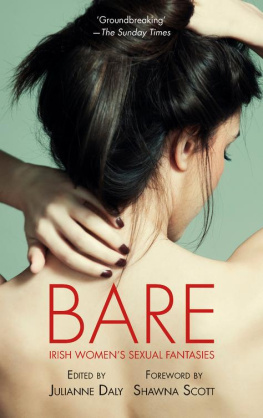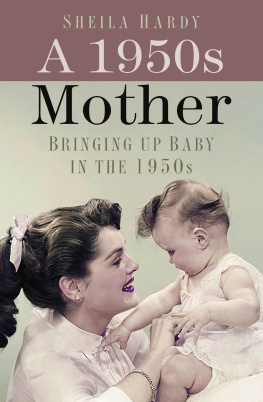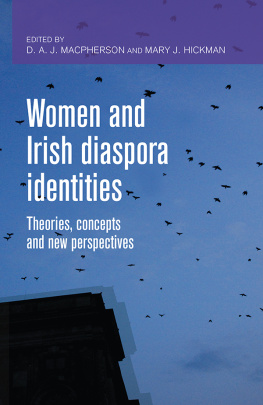My own research journey since 1981 has had many highways and byways, but ever since I started reading, I have loved comics and magazines Playhour , Bunty , Judy , my mothers Womans Way and Womans Realm , my older sisters Nikki (hidden under the mattress because it was considered racy), my friends sisters Petticoat and Honey (retrieved from under sofa cushions in that house), then Jackie , Look Now , and some years later Cosmopolitan , IT , U, Image. So in the 1990s when I started research on womens household work in twentieth-century Ireland, it never occurred to me not to use Irish-produced magazines as a source. Ongoing research into the novelist, playwright, journalist and cookery writer Maura Laverty (190766) also led me to magazines, not only because she wrote regularly for them, but because the Irish magazines I came across were most likely to be addressed to the people she wrote about (and for) in her novels and short stories ordinary (neither very wealthy nor very poor) Irish people in the first five decades of independence.
Another route to this research was an interest I had for a while in Irish womens changing everyday appearance (clothes and hair) between the 1940s and 1960s. I would like to thank Sean Connolly, Anne Dolan and Emmet OConnor for enabling me to road-test some of this research at an earlier stage, in print and in research seminars, and Sle de Clir for her scholarly insight into the interface between traditional and modern dress. While researching this particular topic I found myself straying more and more from the fashion pages to the problem, diary and letters pages and the idea for another book began to grow. Another spur to write was the invitation from two North American academics to write an article on Irish womens magazines for a book they were editing on the changing domestic space of the home. I researched and wrote and submitted the article (on the early years of Womans Way ) but it was not what they wanted, in the end. Id like to thank one of them in particular, Rhona Richman Kenneally, for introducing me to some important North American sources which have proven very useful for comparative purposes and for some interesting conversations on the subject.
The National Library of Ireland was my greatest resource, recourse and refuge. The staff on the issue desk are helpful and pleasant, and the online ordering system works like a dream the material is there ready and waiting. The Reading Room is always pleasant and tranquil. I also caught the lovely walnut-desked British Newspaper Library at Colindale in London shortly before it closed. When the British Librarys magazine collection was inaccessible for a while, and I needed to look at Womans Own, I wrote to the magazine and a very helpful Carolyn Truscott responded. For a week in June 2013 she brought me down to a highly secure basement of the IPC building in Southwark, London, and locked me in for a few hours at a time with Womans Own volumes and a bottle of water, letting me out every few hours for a run around. She was always helpful and pleasant and I thank her from the bottom of my heart.
Norah Casey, CEO Harmonia Publishing, took time out of her busy schedule to talk to me in August 2013, and she was such a mine of information about the magazine publishing world that it occurred to me that somebody should undertake a history of womens magazines in general, on this island, and get her on record about the recent past. It was Professor John Horgan from DCU, former Press Ombudsman, who gave me the idea to talk to Norah, and he had some other very helpful suggestions too, for which I thank him.
Thanks to NUI, Galway for giving me a sabbatical for the calendar year of 2013, in which I did the bulk of the research and much of the writing for this book. Thanks to all my colleagues in the history department at NUI, Galway, for enabling this to happen, and for being such a great bunch of people to work with. These are, in alphabetical order, Gearid Barry, Sarah-Anne Buckley, Helena Condon, Carmel Connolly, John Cunningham, Enrico Dal Lago, Steve Ellis, Toms Finn, Alison Forrestal, Mary Harris, Risn Healy, Pdraig Lenihan, Kimberly LoPrete, Laurence Marley, Niall Ciosin, Dibh Crinn, Kevin OSullivan and Maura Walsh.
History/academic/literary friends who have been an encouragement and help over the past few years are Marie Boran, Ciara Breathnach, Mary Clancy, Maura Cronin, Catriona Crowe, Geraldine Curtin, John Cunningham, Mire Flannery, Gerard Moran, Therese Moylan, Peter Moser, Cliona Murphy, Eunan OHalpin, Eleanor OLeary, Ciaran Murchadha, Gearoid Tuathaigh and Elizabeth Tilley. Thanks to Tadhg hIfearnn for some reflections on the word home as Gaeilge .
I also want to thank the anonymous readers of the initial manuscript for Bloomsbury for their extremely helpful, pertinent and supportive comments. Frances Arnold and Emily Drewe at Bloomsbury have been kind and straightforward from the very beginning, a real pleasure to deal with, while Emma Goode has more than lived up to her surname.
I taught a seminar course on womens magazines and household advice books as a historical source, in NUIG in 201415, and each and every one of the students on it contributed something to my understanding of the meaning of these sources. Thanks, therefore, to Marie Byrt, Daniel Considine, Darragh Darcy, Eoghan Hennessy, Hannah Hughes, Kamile Jucyte, Viktoria Juhaszova, Claire Kelly, Kayleigh Murphy, Steven Nowak, Claire OHalloran, ine Timlin and Sen Walsh, but a special thanks to Kamile, who alerted me to the importance of Miss and Young Woman , and to Darragh, who came across some very interesting online material about Mary Grant/Angela Willans.
The biggest thanks of all go to Pdraig Lenihan.
Bean atighe or bean at/woman of the house : popularly used survival from the Irish (pronounced bana tee ) but often roughly translated into Hiberno-English as the woman of the house meaning the woman in charge of a particular house. The term housewife did not come into popular parlance until the 1970s, and was used mainly by lobbyists (see Irish Housewives Association, below) and advertisers before this decade.
Bean Garda : a female member of the Garda Sochna, see below.
Connacht : see Provinces.
Dil Eireann this is the lower house of the Irish parliament, with elected members who are known as T.D. s. (see below).
Emigration, Report on the Commission : The Commission on Emigration and other Population Problems sat and heard evidence from 1948 to 1954, and issued its report in 1956. It represented an official recognition of the fears of government and other interested parties that Irish population was in apparently irreversible decline, and that emigration was an ineradicable part of Irish life.
Garda Sochna : (lit. the Guardians of the Peace) the unarmed police force, established after independence, often colloquially referred to as the guards. See also Bean Garda .
Humanae Vitae : the papal encyclical written by Pope Paul VI in 1968, which set out the Catholic Churchs position on birth control. It pronounced that while birth control in itself was not wrong, any artificial methods (barrier, pharmaceutical) were against natural law, as was any interruption of the act of sexual intercourse. The only allowable method of birth control, apart from abstinence, was the safe or infertile period.








